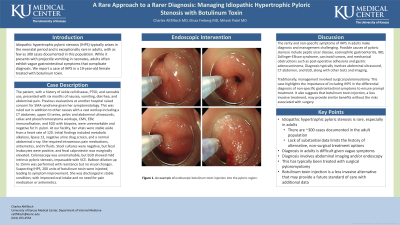Monday Poster Session
Category: Stomach
P3367 - A Rare Approach to a Rarer Diagnosis: Managing Idiopathic Hypertrophic Pyloric Stenosis With Botulinum Toxin
Monday, October 28, 2024
10:30 AM - 4:00 PM ET
Location: Exhibit Hall E

Has Audio

Charlie Altfillisch, MD
University of Kansas Medical Center
Kansas City, MO
Presenting Author(s)
Charles Altfillisch, MD, Elissa Freberg, MD, Mitesh Patel, MD
University of Kansas Medical Center, Kansas City, MO
Introduction: Idiopathic hypertrophic pyloric stenosis (IHPS) typically arises in the neonatal period and is exceptionally rare in adults, with as few as 300 cases documented in this population. While it presents with projectile vomiting in neonates, adults often exhibit vague gastrointestinal symptoms that complicate diagnosis. We report a case of IHPS in a 19-year-old female treated with botulinum toxin.
Case Description/Methods: The patient, with a history of sickle cell disease, PTSD, and cannabis use, presented with six months of nausea, vomiting, diarrhea, and abdominal pain. Previous evaluations at another hospital raised concern for SMA syndrome given her symptomatology. This was ruled out in addition to other causes with a vast workup including a CT abdomen, upper GI series, pelvic and abdominal ultrasounds, celiac and pheochromocytoma workups, CMV, EBV, immunofixation, and EGD with biopsies, were unremarkable and negative for H. pylori. At our facility, her vitals were stable aside from a heart rate of 120. Initial findings included metabolic alkalosis, lipase 13, negative urine drug screen, and a normal abdominal x-ray. She required intravenous pain medications, antiemetics, and IV fluids. Stool cultures were negative, but fecal leukocytes were positive, and fecal calprotectin was marginally elevated. Colonoscopy was unremarkable, but EGD showed mild intrinsic pyloric stenosis, impassable with VCE. Balloon dilation up to 15mm was performed with resistance but no visual changes. Suspecting IHPS, 200 units of botulinum toxin were injected, leading to symptom improvement. She was discharged in stable condition, with improved oral intake and no need for pain medication or antiemetics.
Discussion: The rarity and non-specific symptoms of IHPS in adults make diagnosis and management challenging. Possible causes of pyloric stenosis include peptic ulcer disease, eosinophilic gastroenteritis, IBD, Zollinger-Ellison syndrome, carcinoid tumors, and mechanical obstructions such as post-operative adhesions and gastric adenocarcinoma. Diagnosis typically involves abdominal ultrasound, CT abdomen, and EGD, along with other tests and imaging.
Traditionally, management involved surgical pyloromyotomy. This case highlights the importance of including IHPS in the differential diagnosis of non-specific gastrointestinal symptoms to ensure prompt treatment. It also suggests that botulinum toxin injection, a less invasive treatment, may provide similar benefits without the risks associated with surgery.
Disclosures:
Charles Altfillisch, MD, Elissa Freberg, MD, Mitesh Patel, MD. P3367 - A Rare Approach to a Rarer Diagnosis: Managing Idiopathic Hypertrophic Pyloric Stenosis With Botulinum Toxin, ACG 2024 Annual Scientific Meeting Abstracts. Philadelphia, PA: American College of Gastroenterology.
University of Kansas Medical Center, Kansas City, MO
Introduction: Idiopathic hypertrophic pyloric stenosis (IHPS) typically arises in the neonatal period and is exceptionally rare in adults, with as few as 300 cases documented in this population. While it presents with projectile vomiting in neonates, adults often exhibit vague gastrointestinal symptoms that complicate diagnosis. We report a case of IHPS in a 19-year-old female treated with botulinum toxin.
Case Description/Methods: The patient, with a history of sickle cell disease, PTSD, and cannabis use, presented with six months of nausea, vomiting, diarrhea, and abdominal pain. Previous evaluations at another hospital raised concern for SMA syndrome given her symptomatology. This was ruled out in addition to other causes with a vast workup including a CT abdomen, upper GI series, pelvic and abdominal ultrasounds, celiac and pheochromocytoma workups, CMV, EBV, immunofixation, and EGD with biopsies, were unremarkable and negative for H. pylori. At our facility, her vitals were stable aside from a heart rate of 120. Initial findings included metabolic alkalosis, lipase 13, negative urine drug screen, and a normal abdominal x-ray. She required intravenous pain medications, antiemetics, and IV fluids. Stool cultures were negative, but fecal leukocytes were positive, and fecal calprotectin was marginally elevated. Colonoscopy was unremarkable, but EGD showed mild intrinsic pyloric stenosis, impassable with VCE. Balloon dilation up to 15mm was performed with resistance but no visual changes. Suspecting IHPS, 200 units of botulinum toxin were injected, leading to symptom improvement. She was discharged in stable condition, with improved oral intake and no need for pain medication or antiemetics.
Discussion: The rarity and non-specific symptoms of IHPS in adults make diagnosis and management challenging. Possible causes of pyloric stenosis include peptic ulcer disease, eosinophilic gastroenteritis, IBD, Zollinger-Ellison syndrome, carcinoid tumors, and mechanical obstructions such as post-operative adhesions and gastric adenocarcinoma. Diagnosis typically involves abdominal ultrasound, CT abdomen, and EGD, along with other tests and imaging.
Traditionally, management involved surgical pyloromyotomy. This case highlights the importance of including IHPS in the differential diagnosis of non-specific gastrointestinal symptoms to ensure prompt treatment. It also suggests that botulinum toxin injection, a less invasive treatment, may provide similar benefits without the risks associated with surgery.
Disclosures:
Charles Altfillisch indicated no relevant financial relationships.
Elissa Freberg indicated no relevant financial relationships.
Mitesh Patel indicated no relevant financial relationships.
Charles Altfillisch, MD, Elissa Freberg, MD, Mitesh Patel, MD. P3367 - A Rare Approach to a Rarer Diagnosis: Managing Idiopathic Hypertrophic Pyloric Stenosis With Botulinum Toxin, ACG 2024 Annual Scientific Meeting Abstracts. Philadelphia, PA: American College of Gastroenterology.
